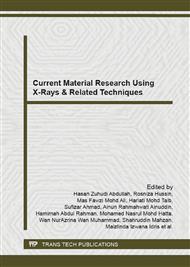p.374
p.379
p.384
p.389
p.394
p.400
p.405
p.410
p.415
A Bentonite Layer between Alumina Foam and its Hydroxyapatite Coat: An Improved Scaffold for Bone Tissue Engineering Applications
Abstract:
It is arguable that successful bone tissue engineering (BTE) protocols relies heavily on scaffolds (i.e., for mechanical support, aid for 3D arrangement, allowing good nutrient and waste transport etc.). In this study, the consequence of adding a bentonite (B) layer between alumina foam (AF) and its hydroxyapatite (HA) coat scaffold is scrutinized by spatial characterization measurement (e.g., porosity, pore size, pore interconnectivity and compressive strength). Other than work on the said hydroxyapatite-bentonite coated alumina foam (HABCAF), spatial characterization efforts were also done for AF and HA coated AF (HACAF) scaffolds. Initially, AF scaffold was fabricated via the foam impregnation technique (FIT). Polyurethane (PU) foam was chosen as a template to ensure controlled porosity and guided pore interconnectivity within the resulting scaffold. HACAF and HABCAF are produced using AF scaffold skeleton, coated with HA and B (for HABCAF only) slurries of different viscosities. After drying and sintering stages, these scaffolds were tested. The results from composite coating show an increase of 40% in strength with the same pore size of PU foam. The HABCAF exhibited the highest compressive strength besides showing good interconnectivity and cell pores sizes (i.e., up to >500 μm). These results suggest that addition of B presents an interesting route in the making of good quality scaffolds for BTE applications.
Info:
Periodical:
Pages:
394-399
Citation:
Online since:
February 2015
Price:
Сopyright:
© 2015 Trans Tech Publications Ltd. All Rights Reserved
Share:
Citation:


